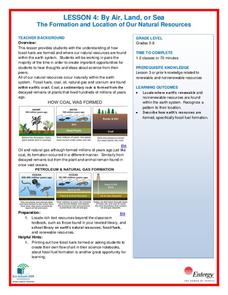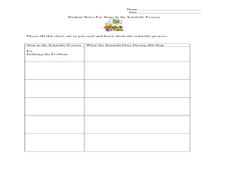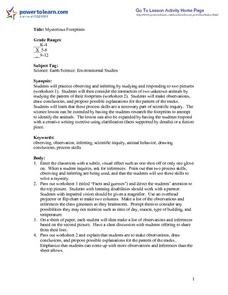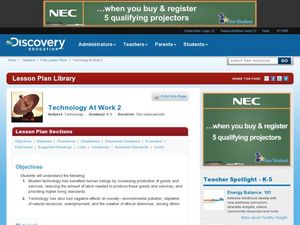Curated OER
Two-Column Chart
In this two-column chart worksheet, learners use the blank graphic organizer template as instructed by their teacher. This t-chart may be used for a variety of classroom activities.
Curated OER
Which One is an Insect?
In this science instructional activity, students categorize 18 words as either insects or not insects. Students write the words in a two-column chart under the correct category.
Baylor College
Plant or Animal?
Teach your class about the necessities of life using the book Tillena Lou's Day in the Sun. After a teacher-read-aloud, students make puppets depicting different plants and animals from the story and illustrating the habitat in...
Science Matters
Oh Heron
Two teams—the environmentalists and herons—play four rounds of the game, Oh Heron. Using hand symbols to represent food, shelter, and water, players locate their match to produce more herons while those unmatched decompose.
Curated OER
Sea Turtle Rescue
Students create a three column chart about working with wildlife and how different organizations help sea turtles. In this sea turtles lesson plan, students compare the Oregon Coast Aquarium, the Coast Guard, and Sea World and what they...
Curated OER
Know Your Aquarium
Students name elements that are necessary parts of a healthy human habitat. They create a two column chart. In the second column, students list elements fish need in order to survive in the aquarium. Students understand the aquarium and...
Virginia Department of Education
Atomic Structure: Periodic Table
The fifth lesson of seven in the series outlines an in-depth analysis of the periodic table. After direct instruction, pupils take turns practicing in the group before beginning independent study. The assessments include a...
Curated OER
Review of Ionic and Covalent Compounds and Transitioning from Ionic to Covalent Compounds
Here is a unique assigment: compare and contrast ionic and covalent compounds in an extensive data table and then analyze Lewis dot structures in antoher. Three columns are to befilled in: "characteristic or feature," "applies to ionic...
Curated OER
4.2: Exploring Rocks
Students collect and look at rocks and write down information about them in science notebooks. They make comparisons and sort the rocks according to their properties, and then discuss their findings with their classmates and put them on...
Curated OER
Unit II: Worksheet 5 - Velocity and Motion Maps
A chart with eight rows makes up this handout. The columns are labeled with two graphs ("x vs. t" and "v vs. t"), a written description, and a motion map. One cell in each row is filled in, leaving the rest for your class to complete....
Curated OER
Project 1
Learners are given a coin to observe and make inferences about. Using a worksheet, they make two columns to list their observations and inferences in an organized manner. They develop a hypothesis based on one of the inferences and...
Curated OER
More Rocket Science
Students observe two rocket science experiments, and create a graph to demonstrate the results. They draw a picture and write an explanation of the results of the experiments.
Curated OER
Sounds Good To Me
Students view and discuss a video about sounds. They complete a worksheet that sorts sounds according to two columns - sounds students might hear in their neighborhoods and sounds they would not.
National Wildlife Federation
By Air, Land, or Sea: The Formation and Location of Our Natural Resources
Coal forms from the ancient remains of plants that were alive on Earth before the dinosaurs! Scholars use their t-charts from the previous lesson over resources and research to determine if their information is correct. Through analysis...
Curated OER
Student Notes for Steps in the Scientific Process
In this science inquiry skills worksheet, students fill out a blank chart as they read and learn about the scientific process. The chart has two columns with the titles, "Step in the Scientific Process" and "What the Scientist Does...
Curated OER
Mysterious Footprints
Students, after observing and responding to two pictures, consider the interaction of two unknown animals by examining the pattern of their footprints. They make observations, draw conclusions and propose possible explanations for the...
Curated OER
Under the Sea
Young scholars identify and interpret that non-fiction books have features like a table of contents, a glossary, and an index, which can efficiently help them find information. They also identify how to narrow the search for information...
Curated OER
Inuit and Arctic Animals
Students will explore the animals and people living in the Arctic. In this science lesson, students locate Alaska on a globe, discuss its climate and geographical features, and identify common arctic animals. Students complete the first...
Curated OER
Three R's to Environmental Stewardship: Earth Day
Students explore the ways to conserve our natural resources. In this recycling, reusing, and reducing lesson students read Dinosaurs to the Rescue and apply their findings to learning ways to conserve resources. Students complete a...
Curated OER
Technology at Work 2
Students discover the positive and negative effects of technology. In this technology lesson, students give examples of technology advances from the past few years. Students get into groups and debate whether a particular item has hurt...
NOAA
The Oceanographic Yo-yo
How does chemistry help deep-sea explorers? Part four of a five-part series of lessons from aboard the Okeanos Explorer introduces middle school scientists to technologies used in ocean exploration. Groups work together to analyze data...
Curated OER
Friction and Gravity
Seventh graders identify the factors that determine the strength of the friction forces when two objects push against each other. Describing the difference between weight and mass, they participate in experiments. They state the law of...
Curated OER
Dreaming of Gardens
Students demonstrate ways to be an environmental philanthropist. In this philanthropy lesson, students read The Gardener and Just a Dream and compare the two books. Students discuss ways the characters demonstrated environmental...
Curated OER
Basic Knowledge of Big Cats
First graders create a KWL chart on big cats. In this animal science lesson, 1st graders brainstorm what they already know about big cats and research big cats using various suggested websites. Students fill in the last column of the KWL...








